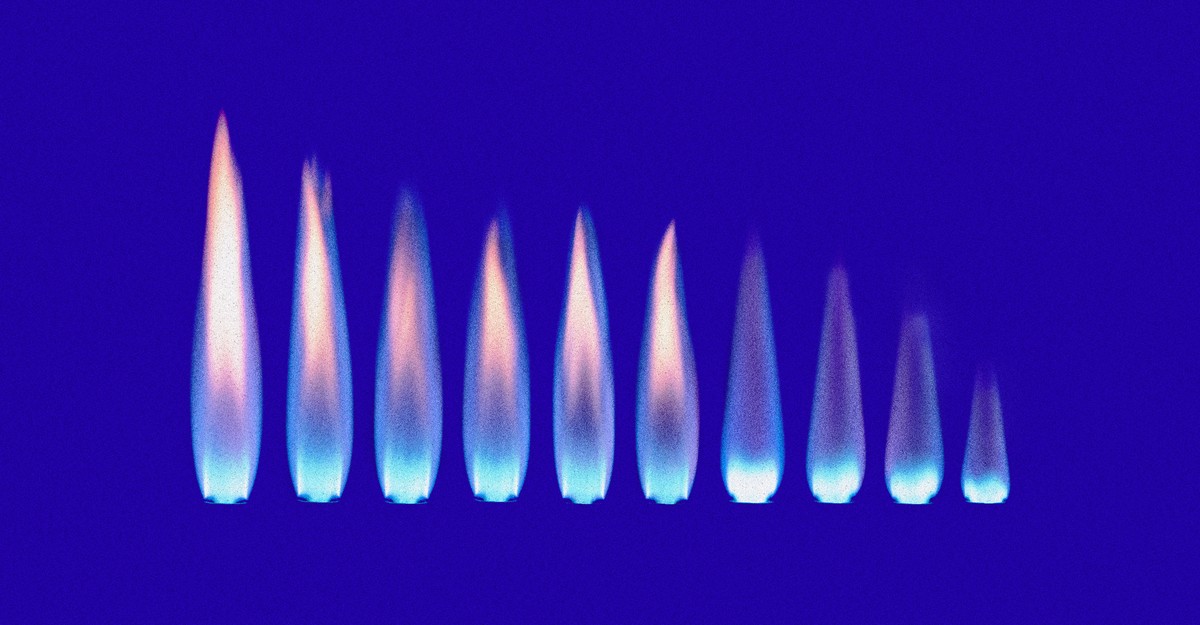Somehow, in a few short days, gas stoves have gone from a thing that some people cook with to, depending on your politics, either a child-poisoning death machine or a treasured piece of national patrimony. Suddenly, everyone has an opinion. Gas stoves! Who could have predicted it?
The roots of the present controversy can be traced back to late December, when scientists published a paper arguing that gas stoves are to blame for nearly 13 percent of childhood-asthma cases in the United States. This finding was striking but not really new: The scientific literature establishing the dangers of gas stoves—and the connection to childhood asthma in particular—goes back decades. Then, on Monday, the fracas got well and truly under way when Richard Trumka Jr., a member of the Consumer Product Safety Commission, said in an interview with Bloomberg News that the commission would consider a full prohibition on gas stoves. “This is a hidden hazard,” he said. “Any option is on the table. Products that can’t be made safe can be banned.”
Just like that, gas stoves became the newest front in America’s ever-expanding culture wars. Politicians proceeded to completely lose their minds. Florida Governor Ron DeSantis tweeted a cartoon of two autographed—yes autographed—gas stoves. Representative Jim Jordan of Ohio declared simply, “God. Guns. Gas stoves.” Naturally, Tucker Carlson got involved. “I would counsel mass disobedience in the face of tyranny in this case,” he told a guest on his Fox News show.
No matter that Democrats are more likely to have gas stoves than Republicans, and, in fact, that the only states in which a majority of households use gas stoves—California, Nevada, Illinois, New York, New Jersey—are states that went blue in 2020. Why let a few pesky facts spoil a perfectly good opportunity to own the libs? The Biden administration, for its part, clarified yesterday that it has no intention of banning gas stoves. In the long run, though, this may prove to have been more a stay of execution than a pardon.
Beyond the knee-jerk partisanship, the science of gas stoves is not entirely straightforward. Emily Oster, an economist at Brown University, suggested in her newsletter that the underlying data establishing the connection between gas-stove use and childhood asthma may not be as clear-cut as the new study makes it out to be. And because those data are merely correlational, we can’t draw any straightforward causal conclusions. This doesn’t mean gas stoves are safe, Oster told me, but it does complicate the picture. Switching from gas to electric right this minute probably isn’t necessary, she said, but she would make the change if she happened to be redesigning her kitchen.
Whatever the shortcomings of the available data, it’s clear that gas stoves are worse for the climate and fill our homes with pollutants we’re better off not inhaling. Brady Seals, a manager at the Rocky Mountain Institute and a lead author of the new paper, told me that even assuming the maximum amount of uncertainty, her work still suggests that more than 6 percent of childhood-asthma cases in the U.S. are associated with gas stoves.
Regardless of the exact science, gas stoves might be in trouble anyway. Statistically, they’re not all that deeply entrenched to begin with: Only about 40 percent of American households have one. Plus, induction stoves—a hyperefficient option that generates heat using electromagnetism—are on the rise. “We’re not asking people to go back to janky coils,” says Leah Stokes, a political scientist at UC Santa Barbara who has provided testimony on the subject of gas stoves before the U.S. Senate, and who is currently in the process of installing an induction stove in her home.
Rachelle Boucher, a chef who has worked in restaurants, in appliance showrooms, and as a private cook for such celebrity clients as George Lucas and Metallica, swears by induction. She started using it about 15 years ago and has since become a full-time evangelist. (In the past, Boucher did promotions for electric-stove companies, though she doesn’t anymore.) Induction, she told me, tops gas in just about every way. For one thing, “the speed is remarkable.” An induction stove top can boil a pot of water in just two minutes—twice as fast as a gas burner. For another, it allows for far greater precision: When you adjust the heat, the change is nearly instantaneous. “Once you use that speed,” Boucher said, “it’s weird to go back and have everything be so much harder to control.” Induction stoves also emit virtually no excess heat, reducing air-conditioning costs and making it harder to burn yourself. And they’re easier to clean.
Induction stoves do have minor drawbacks. Because they are flat and use electromagnetism, they aren’t compatible with all cookware, meaning that if you make the switch, you may also have to buy yourself a new wok or kettle. Flambéing and charring will also take a little longer, Boucher told me, but few home cooks are deploying those techniques on a regular basis. In recent years, induction has received the endorsement of some of the world’s top chefs, who have tended to be ardent gas-stove users. Eric Ripert, whose restaurant Le Bernardin has three Michelin stars, switched his home kitchens from gas to induction. “After two days, I was in love,” he told The New York Times last year. At his San Francisco restaurant, Claude Le Tohic, a James Beard Award–winning chef, has made the switch to induction. The celebrity chef and food writer Alison Roman is also a convert: “I have an induction stove by choice AMA,” she tweeted yesterday.
If it’s good enough for them, it’s probably good enough for us. At the moment, induction stoves are more expensive than the alternatives, although their efficiency and the fact that they don’t heat up the kitchen help offset the disparity. So, too, do the rebates included in last year’s Inflation Reduction Act, which should kick in later this year and can amount to as much as $840. The price has been falling in recent years, and as it continues to come down, Stokes told me, she expects induction to overtake gas. A 2022 Consumer Reports survey found that although 3 percent of Americans have induction stoves, nearly 70 might consider going induction the next time they buy new appliances. “I think the same thing’s going to happen for induction stoves” as happened with electric vehicles, Stokes told me. In the end, culture-war considerations will lose out to questions of cost and quality. The better product will win the day, plain and simple.
Still, gas stoves’ foray into the culture wars likely means that at least some Republicans will probably scorn electric stoves now in the same way they have masks over the past few years. And this whole episode does have a distinctly post-pandemic feel to it: the concern about the air we’re breathing, the discussion of what precautions we ought to take, the panic and outrage in response. The new gas-stove controversy feels as though it has been jammed into a partisan framework established—or at least refined—during the pandemic. “I don’t know if this discourse that we’re seeing now could have happened five years ago,” Brady Seals told me. Whatever happens to gas stoves, the public-health culture wars don’t seem to be going anywhere.






